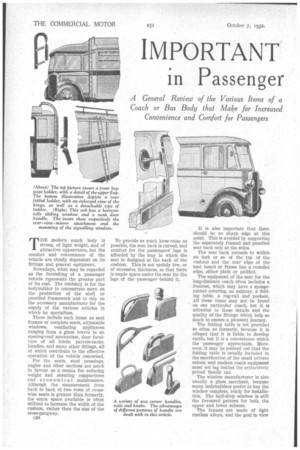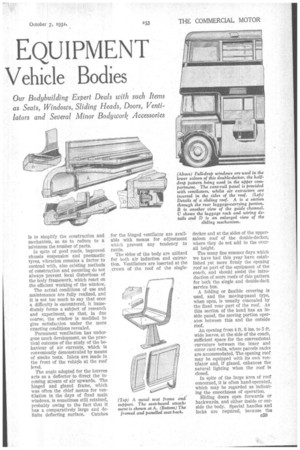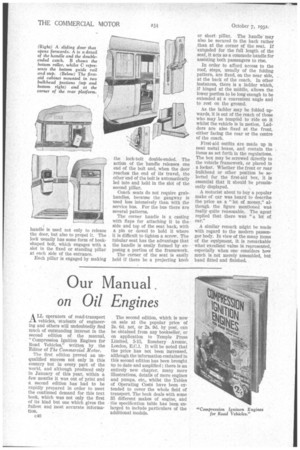IMPORTANT
Page 88

Page 89

Page 90

If you've noticed an error in this article please click here to report it so we can fix it.
in Passenger
EQUIPMENT Vehicle Bodies
A General Review of the Various Items of a Coach or Bus Body that Make for Increased Convenience and Comfort for Passengers Our Bodybuilding Expert Deals with such Items as Seats, Windows, Sliding Heads, Doors, Ventilators and Several Minor Bodywork Accessories
THE modern coach body is strong, of light weight, and of attractive appearance, but the comfort and convenience of the vehicle are chiefly dependent on its fittings and general equipment.
Nowadays, what may be regarded as the furnishing of a passenger vehicle represents the greater part of its cost. The tendency is for the bodybuilder to concentrate more on the production of the shell or panelled framework and to rely on the accessory manufacturer for the supply of the various articles in which he specializes.
These include such items as seat frames or, complete seats, adjustable windows, ventilating appliances ranging from a glass louvre to an opening-roof mechanism, door furniture of all kinds, parcels-racks, handles, and many other fittings, all of which contribute to the effective operation of the vehicle concerned. , For the seats, steel pressings, angles and other sections are much in favour as a means for reducing weight and ensuring compactness and economical maintenance. Although the measurement from back to back of two rows of crosswise seats is greater than formerly, the extra space available is often utilized to increase the width of the cushion, rather than the size of the cross-gangway.
c38
To provide as much knee-room as possible, the seat back is curved, and Comfort for the passengers' legs is afforded by the way in which the seat is designed at the back of the cushion. This is not unduly low, or of excessive thickness, so that there is ample space under the seat for the legs of the passenger behind it.
It is also important that there should be no sharp edge at this point. This is avoided by supporting the separately framed and panelled seat back only at the sides.
The seat back extends to within an inch or so of the top of the cushion and the rear edge of the seat board or frame has a rounded edge, either plain or padded.
The equipment of the seat for the long-distance coach often includes a footrest, which may have a spongerubber covering, an ashtray, a folding table, a rug-rail and pockets. All these items may not be found on one particular coach, but it is attention to these details and the quality of the fittings which help so much to ensure a pleasant journey.
The folding table is not provided so often as formerly, because it is alleged that it is liable to develop rattle, but it is a convenience which the passenger appreciates. Moreover, it may he pointed out that the folding table is usually included in the specification of the small private saloon, and modern coach equipment must not lag behind the attractively priced family car.
The window manufacturer is also usually a glass merchant, because many bodybuilders prefer to buy the window complete, ready for installation. The half-drop window is still the favoured pattern for both the upper and lower saloons.
The frames are made of light rustIess alloys, and the goal in view is to simplify the construction and mechanism, so as to reduce to a minimum the number of parts.
In spite of good roads, improved chassis suspension and pneumatic tyres, vibration remains a factor to contend with, also existing methods of construction and mounting do not always prevent local distortions of the body framework, which react on the efficient working of the window.
The actual conditions of use and maintenance are fully realized, and it is not too much to say that once a difficulty is encountered, it immediately forms a subject of research and experiment, so that, in due course, the window is modified to give satisfaction under the more exacting conditions revealed.
Permanent ventilation has undergone much development, as the practical outcome of the study of the behaviour of air currents, which is conveniently demonstrated by means of smoke tests. Inlets are made in the front of the vehicle at the roof level.
The angle adopted for the louvres acts as a deflector to direct the incoming stream of air upwards. The hinged and glazed frame, which was often the chief means for ventilation in the days of fixed main windows, is sometimes still retained, probably owing to the fact that it has a comparatively large and de finite deflecting surface. Catches for the hinged ventilator are available with means for adjustment which prevent any tendency to rattle.
The sides of the body are utilized for both air induction and extraction. Ventilators are inserted at the crown of the roof of the single decker and at the sides of the uppersaloon roof of the double-decker, where they do not add to the overall height.
The many fine summer days which we have had this year have established yet more firmly the opening roof as part of the equipment of the coach, and should assist the introduction of more roofs of this pattern for both the single and double-deck service bus.
A folding or flexible covering is used, and the moving-panel type, when open, is usually concealed by the fixed rear part of the roof. As this section of the head has an inside panel, the moving portion operates between this and the outside roof.
An opening from 4 ft. 6 ins. to 5 ft. wide leaves, at the side of the coach, sufficient space for the conventional curvature between the inner and outer cant-rails, where parcels racks are accommodated. The opening roof may he equipped with its own ventilator and, if glazed, enhances the natural lighting when the roof is closed, In spite of the large area of roof concerned, it is often hand-operated, which may be regarded as indicating the smoothness of operation.
Sliding doors open forwards or backwards, and either inside or outside the body. Special handles and locks are required, because the handle is used not only to release the door, but also to propel it. The lock usually has some form of hookshaped bolt, which engages with a slot in the fixed or standing pillar at each side of the entrance.
Each pillar is engaged by making the lock-bolt double-ended. The action of the handle releases one end of the bolt and, when the door reaches the end of its travel, the other end of the bolt is automatically led into and held in the slot of the second pillar.
Coach seats do not require grabhandles, because the gangway is used less intensively than with the service bus. For the bus there are several patterns.
The corner handle is a casting with flaps for attaching it to the side and top of the seat back, with a pin or dowel to hold it where it is difficult to tighten a screw. The tubular seat has the advantage that the handle is easily formed by exposing a portion of the framework.
The corner• of the seat is easily held if there be a projecting knob or short pillar. The handle may also be secured to the back rather than at the corner of the seat. If extended for the full length of the seat, it acts as a commode handle for assisting both passengers to rise.
In order to afford access to the roof, steps, usually of the folding pattern, are fixed, on thenear side, at the back of the coach. In other instances, there is a ladder which, if hinged at the middle, allows the lower portion to be long enough to be extended at a convenient angle and to rest on the ground.
As the ladder may be folded upwards, it is out of the reach of those who may be tempted to ride on it whilst the vehicle is in motion. Ladders are also fixed at the front, either facing the rear or the centre of the coach.
First-aid outfits are made up in neat metal boxes, and contain the items as set forth in the regulations. The box may be screwed directly to the vehicle framework, or placed in a locker. Whether the front or rear bulkhead or other position be selected for the first-aid box, it is essential that it should be prominently displayed.
A motorist about to buy a popular make of car was heard to describe the price as a "lot of money," although the figure mentioned waS really quite reasonable. The agent replied that there was "a lot of car."
A similar remark might be made with regard to the modern passenger body. In view of the many items of the equipment, it is remarkable what excellent value is represented, especially when one considers how much is not merely assembled, but hand fitted and finished.




































































































































































